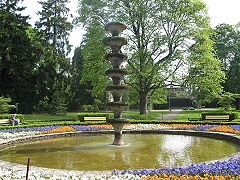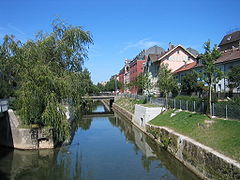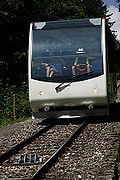Biel/Bienne
Biel/Bienne | |
|---|---|
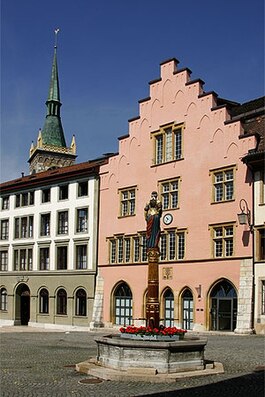 City Hall in the Old Town of Biel/Bienne | |
| Twin towns | Iserlohn (Germany) |
| Website | www SFSO statistics |

Biel/Bienne (official bilingual wording; German: Biel, French: Bienne; German pronunciation: [biːl] ⓘ, French pronunciation: [bjɛn])[3] is a bilingual city in the canton of Bern in Switzerland. With over 55,000 residents, it is the country's tenth-largest city by population. The Biel urban area has a population of around 100,000 inhabitants.[4] Biel/Bienne is the capital of the Biel/Bienne administrative district. The city has been an industrial and watchmaking heart of Switzerland since the 19th century. With world-famous watch brands such as Rolex, Omega and Swatch based in Biel/Bienne, the city is one of the main centres of the Swiss watch industry and is also referred to as the "world capital of watchmaking".[5][6]
Biel/Bienne lies on the language boundary between the
The city lies at the foot of the first mountain range of the
History
Prehistoric settlements

The shoreline of Lake Biel has been inhabited since at least the
A theory holds that the toponym is derived from the name of
The town is mentioned in 1142 as Apud Belnam,
Foundation


In the 5th century, the area was invaded by the
Officially, Biel remained under the jurisdiction of the
The town's church, the Church of St. Benedict, was first mentioned in 1228. The current church was built in 1451–70 and is regarded, after Bern Cathedral, as the second most important late gothic building in the Canton of Bern.[10]
An associate of the Swiss Confederation
While it officially remained part of the lands of the Prince-Bishopric of Basel, starting in the 13th century Biel began making alliances with neighboring nobles and cities. In 1279 it allied with Bern. This first alliance was followed in 1311 by an alliance with Fribourg, a 1334 alliance with Solothurn, 1342 with Murten and 1395 with La Neuveville. The alliance with Bern became an eternal alliance in 1352, as Bern itself joined the Old Swiss Confederacy. Contradictory obligations to the Bishop of Basel, Jean de Vienne, and to the Imperial City of Bern led to a war in 1367. During the war, Biel was burned and the Bishop's castle was destroyed. After the extinction of the Counts of Neuchâtel-Nidau in 1375 the Bishop's power around the lake began to wane. In 1388, Bern gained control of Nidau Castle and the town of Nidau. However, the Bishop retained nominal power and influence in Biel. The two competing powers struggled for power in Biel for over 400 years and prevented the town from becoming completely independent from either powerful neighbor.[10]
Biel was considered an
Even though Biel remained nominally under the control of the Catholic Bishops of Basel, in 1528 it converted to the new
From the French invasion to modern Biel/Bienne


The
After the collapse of the

By the beginning of the 20th century
The First World War meant a setback for the labor movement, even though Switzerland was not directly involved in the war. Wages were reduced significantly when the war started while inflation made everything more expensive. In July 1918, a demonstration of starving workers erupted into street riots that required military action to suppress.
In 1919 a Communist Party was founded in Biel, but it remained a minor party in the town. In 1921, the Social Democrats won a slim majority in the city councils. Under the leadership of the Social Democratic Mayor Guido Müller "Red Biel" began a series of socialist community experiments. During the 1930s the entire neighborhood around the train station was redeveloped according to the social planning theories of the era. The Volkshaus (People's House), built under the direction of Edward Lanz between 1928 and 1932, is an example of the "new building" style and a symbol of the Social Democratic era of the city.
In the years leading up to the Second World War, the Social Democrats began to lose power in the city. In the last year of the war, the Swiss Party of Labour gained nine seats on the city council and ended the Social Democrat majority. With the resignation of Mayor Müller in 1947, it would be almost thirty years (1976) before the Social Democrats had another mayor in Biel.[10]
On the occasion of the secession of the canton of Jura in 1978, Biel had been asked to become its capital, but it remained with the canton of Bern.
The town was officially named Biel or Bienne until 2004, even though the bilingual Biel-Bienne was in common use. Since 2005, the official name has been Biel/Bienne, with forward slash.[11]
At the beginning of the 20th century, the town's population was at 30,000 people. It doubled over the next 60 years, peaking at 65,000 in the mid-1960s. It declined gradually over the 1970s to 1990s, to below 49,000 in 2000, again rising slightly to just over 50,000 during the 2000s. Another 89,000 people live in the immediately surrounding
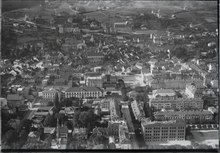
Geography and climate
Topology

Biel/Bienne has an area of 21.19 km2 (8.18 sq mi).[12] Of this area, 1.7 km2 (0.66 sq mi) or 8.0% is used for agricultural purposes, while 9.63 km2 (3.72 sq mi) or 45.4% is forested. Of the rest of the land, 9.65 km2 (3.73 sq mi) or 45.5% is settled (buildings or roads), 0.13 km2 (32 acres) or 0.6% is either rivers or lakes and 0.14 km2 (35 acres) or 0.7% is unproductive land.[13]
Of the built up area, industrial buildings made up 5.1% of the total area while housing and buildings made up 21.9% and transportation infrastructure made up 12.6%. Power and water infrastructure as well as other special developed areas made up 1.7% of the area while parks, green belts and sports fields made up 4.1%. Out of the forested land, all of the forested land area is covered with heavy forests. Of the agricultural land, 4.7% is used for growing crops and 2.0% is pastures. All the water in the municipality is flowing water.[13]
The municipality is at the southeastern foot of the Jura Mountains on the northeast end of Lake Biel. It consists of the village of Biel/Bienne, Vingelz (since 1900), Bözingen (since 1917), Madretsch and Mett (both since 1920).
On 31 December 2009 Amtsbezirk Biel, the municipality's former district, was dissolved. On the following day, 1 January 2010, it joined the newly created Verwaltungskreis Biel/Bienne. It remained the capital of the new Verwaltungskreis.[7]
Climate
| Climate data for Biel/Bienne (1981–2010) | |||||||||||||
|---|---|---|---|---|---|---|---|---|---|---|---|---|---|
| Month | Jan | Feb | Mar | Apr | May | Jun | Jul | Aug | Sep | Oct | Nov | Dec | Year |
| Mean daily maximum °C (°F) | 3.7 (38.7) |
5.6 (42.1) |
10.7 (51.3) |
14.9 (58.8) |
19.6 (67.3) |
22.9 (73.2) |
25.6 (78.1) |
25.0 (77.0) |
20.5 (68.9) |
14.7 (58.5) |
8.0 (46.4) |
4.7 (40.5) |
14.7 (58.5) |
| Daily mean °C (°F) | 0.7 (33.3) |
1.6 (34.9) |
5.5 (41.9) |
9.5 (49.1) |
14.0 (57.2) |
17.4 (63.3) |
19.7 (67.5) |
18.9 (66.0) |
14.8 (58.6) |
10.3 (50.5) |
4.8 (40.6) |
1.8 (35.2) |
9.9 (49.8) |
| Mean daily minimum °C (°F) | −1.5 (29.3) |
−1.4 (29.5) |
1.6 (34.9) |
4.7 (40.5) |
9.1 (48.4) |
12.4 (54.3) |
14.4 (57.9) |
14.0 (57.2) |
10.6 (51.1) |
7.1 (44.8) |
2.2 (36.0) |
−0.4 (31.3) |
6.1 (43.0) |
| Average precipitation mm (inches) | 101 (4.0) |
88 (3.5) |
89 (3.5) |
79 (3.1) |
100 (3.9) |
100 (3.9) |
102 (4.0) |
113 (4.4) |
97 (3.8) |
104 (4.1) |
98 (3.9) |
117 (4.6) |
1,187 (46.7) |
| Average snowfall cm (inches) | 14.8 (5.8) |
13.2 (5.2) |
5.6 (2.2) |
0.8 (0.3) |
0 (0) |
0 (0) |
0 (0) |
0 (0) |
0 (0) |
0 (0) |
3.7 (1.5) |
13.6 (5.4) |
51.7 (20.4) |
| Average precipitation days (≥ 1.0 mm) | 10.7 | 10.0 | 10.7 | 10.2 | 12.2 | 10.8 | 10.6 | 10.6 | 8.8 | 10.8 | 10.5 | 11.5 | 127.4 |
| Average snowy days (≥ 1.0 cm) | 4.1 | 3.4 | 1.8 | 0.3 | 0 | 0 | 0 | 0 | 0 | 0 | 1 | 2.9 | 13.5 |
| Average relative humidity (%)
|
85 | 80 | 73 | 69 | 70 | 69 | 67 | 71 | 76 | 83 | 84 | 85 | 76 |
| Source: MeteoSwiss[14] | |||||||||||||
Politics
Coat of arms
The blazon of the municipal coat of arms is Gules two Axes Argent in saltire.[15]
Subdivisions
Government
The Municipal Council (fr: Conseil municipal, de: Gemeinderat) constitutes the executive government of the City of Biel/Bienne and operates as a collegiate authority. It is composed of five councilors (French: Conseiller municipal/ Conseillère municipale, German: Gemeinderat/ Gemeinderätin), each presiding over a directorate. The president of the presidential directorate acts as mayor (fr: Maire, de: Stadtpräsident). In the mandate period 2021–2024 (législature, Legislatur) the Municipal Council is presided by Maire/ Stadtpräsident Erich Fehr. Departmental tasks, coordination measures and implementation of laws decreed by the City Council (parliament) are carried by the Municipal Council. The regular election of the Municipal Council by any inhabitant valid to vote is held every four years. Any resident of Biel/Bienne allowed to vote can be elected as a member of the Municipal Council. The current mandate period is from 1 January 2021 to 31 December 2024. The mayor is elected as such by public election by means of a system of Majorz, while the heads of the other directorates are assigned by the collegiate. The delegates are selected by means of a system of Proporz.[16]
As of 2021[update], Biel/Bienne's Municipal Council is made up of two representatives of the PS/SP (
| Municipal Councillor (Conseiller communal/ Conseillère communale, Stadtrat/ Stadträtin) |
Party | Head of Directorate (Directeur/Directrice de, Direktor/Direktorin, since) of |
elected since | Native language |
|---|---|---|---|---|
| Erich Fehr[CC 1] | PS | Mayor's Office (mairie/ Präsidialdirektion, 2011) | 2010 | DE |
| Silvia Steidle[CC 2] | PRR | Finance (Direction des finances/ Finanzdirektion, 2009) | 2008 | FR |
| Beat Feurer | SVP | Social Services and Security (Direction de l'action sociale et de la sécurité/ Direktion Soziales und Sicherheit, 2013) | 2012 | DE |
| Glenda Gonzalez Bassi | PSR | Education, Culture, and Sports (Direction de la formation, de la culture et du sport/ Direktion Bildung, Kultur und Sport, 2021) | 2020 | FR |
| Lena Frank | GB | Civil Engineering and Construction, Energy, and Environmental Sustainability (Direction des travaux publics, de l'énergie et de l'environnement/ Direktion Bau, Energie und Umwelt, 2021) | 2020 | DE |
Barbara Labbé is Town Chancellor (chancelière municipale/ Stadtschreiberin) since , and Bertrand Cottier is Deputy Town Chancellor (vice-chancelier/ Vize-Stadtschreiber) since for the Municipal Council.
Parliament
The Conseil de ville/Stadtrat of Biel/Bienne for the mandate period of 2021–2024
The City Council (fr: Conseil de ville, de: Stadtrat), the city parliament, holds
The sessions of the City Council are public. Unlike members of the Municipal Council, members of the City Council are not politicians by profession, and they are paid a fee based on their attendance. Any resident of Biel/Bienne allowed to vote can be elected as a member of the City Council. The Parliament holds its meetings in the Stadtratssaal.[19]
The last regular election of the City Council was held on 27 September 2020 for the mandate period (la législature) from 2021 to 2024. The voter turnout was 39.23%.[17]
Currently the City Council consist of 18 members of the
Elections
National Council
In the
In the
In the
International relations
Biel/Bienne is
 Iserlohn, Germany (since 1959)
Iserlohn, Germany (since 1959)
Demographics
Population
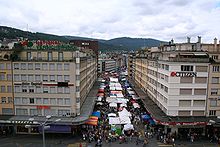

Biel/Bienne has a population (as of December 2020[update]) of 55,206.[23] As of 2010[update], 28.1% of the population are resident foreign nationals. Over the last 10 years (2000–2010) the population has changed at a rate of 3.8%. Migration accounted for 7.8%, while births and deaths accounted for −1.4%.[24]
Of the population in the municipality, 15,339 or about 31.5% were born in Biel/Bienne and lived there in 2000. There were 8,990 or 18.5% who were born in the same canton, while 9,170 or 18.8% were born somewhere else in Switzerland, and 12,244 or 25.2% were born outside of Switzerland.[25]
As of 2010[update], children and teenagers (0–19 years old) make up 18.8% of the population, while adults (20–64 years old) make up 61.9% and seniors (over 64 years old) make up 19.3%.[24]
As of 2000[update], there were 19,980 people who were single and never married in the municipality. There were 21,188 married individuals, 3,727 widows or widowers and 3,760 individuals who are divorced.[25]
As of 2000[update], there were 11,014 households that consist of only one person and 797 households with five or more people. In 2000[update], a total of 23,367 apartments (86.8% of the total) were permanently occupied, while 2,169 apartments (8.1%) were seasonally occupied and 1,398 apartments (5.2%) were empty.[26] As of 2010[update], the construction rate of new housing units was 3.2 new units per 1000 residents.[24]
As of 2003[update] the average price to rent an average apartment in Biel/Bienne was 935.83 Swiss francs (CHF) per month. The average rate for a one-room apartment was 463.73 CHF, a two-room apartment was about 706.49 CHF, a three-room apartment was about 846.98 CHF and a six or more room apartment cost an average of 1749.16 CHF. The average apartment price in Biel/Bienne was 83.9% of the national average of 1116 CHF.[27] The vacancy rate for the municipality, in 2011[update], was 2%.
Historic population
The historical population is given in the following chart:[10]
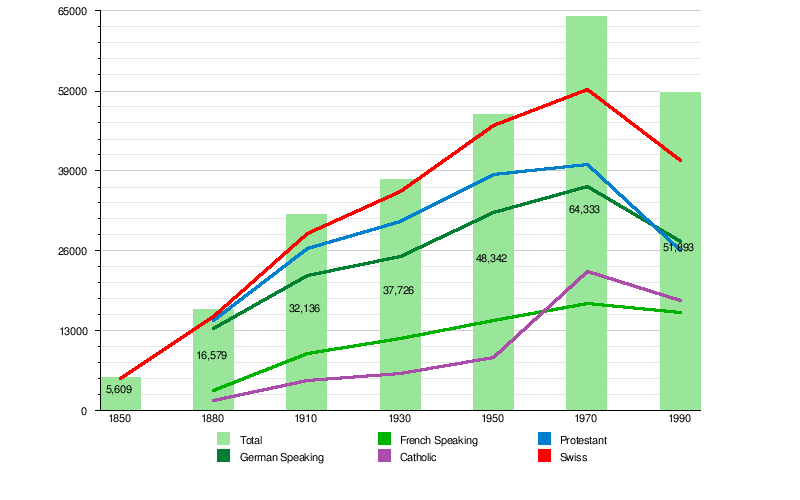
| Historic Population Data[10] | |||||||||||
|---|---|---|---|---|---|---|---|---|---|---|---|
| Year | Total Population | German Speaking | French Speaking | Catholic | Protestant | Christian Catholic | Jewish | Other religions | No religion given | Swiss | Non-Swiss |
| 1770 | 1,698 | ||||||||||
| 1818 | 3,589 | ||||||||||
| 1850 | 5,609 | 5,268 | 341 | ||||||||
| 1880 | 16,579 | 13,253 | 3,207 | 1,675 | 14,620 | 240 | 77 | 15,323 | 1,289 | ||
| 1910 | 32,136 | 22,017 | 9,209 | 4,840 | 26,366 | 413 | 517 | 28,723 | 3,413 | ||
| 1930 | 37,726 | 24,946 | 11,673 | 6,031 | 30,750 | 310 | 635 | 35,588 | 2,338 | ||
| 1950 | 48,342 | 32,188 | 14,598 | 8,659 | 38,314 | 572 | 268 | 529 | 46,232 | 2,110 | |
| 1970 | 64,333 | 36,354 | 17,396 | 22,745 | 40,032 | 282 | 178 | 1,096 | 52,148 | 12,185 | |
| 1990 | 51,893 | 27,510 | 15,906 | 17,857 | 26,123 | 116 | 69 | 7,728 | 3,959 | 40,576 | 11,317 |
Language

In 2000, a majority of the population spoke German (26,957 or 55.4%) as their first language. French was the second most common (13,695 or 28.1%) and Italian was third (2,925 or 6.0%). There were 37 people who spoke Romansh.[25] German and French are both official languages of Biel/Bienne, which is the largest bilingual city in Switzerland.
In 2020, when asked specifically about the two official languages, 32,154 residents (56.8% of the population) mentioned German as their principal language, while 24,376 (43.2%) mentioned French.[28]
In recent years the city has used its linguistic assets as an economic advantage, becoming the Swiss City of Communication. Several call centres have been created in or around Biel, in addition to the traditional businesses established in the city and surrounding area, which have always exported most of their production worldwide.
Religion
According to the 2000 census[update], 19,191 people or 39.4% of the total population, belonged to the
Tourism
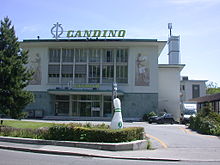
Biel/Bienne is located near the watch-making cities of
The
In 2016 a total of 50,646 visitors spent 87,937 lodging nights in Biel/Bienne.[29]
Heritage sites of national significance
The Alte Krone/La vieille Couronne, the artist's studio Atelier Robert, the former Rockhall
-
Alte Krone, Vieille Couronne
-
Atelier Robert
-
The former Rockhall Manor building
-
Main Train Station
-
Jordi-Kocher House
-
Catholic parish church of St. Maria Immaculata
-
Kongresshaus, Palais des congrès, (Convention Center)
-
Kontrollgebäude at Zentralstrasse 49 / Oberer Quai 2
-
Museum Neuhaus
-
Museum Schwab
-
Swiss Reformed City Church
-
Administration Building and Montage Hall for General Motors
-
Volkshaus, Maison du Peuple Building
-
Waldleute Zunft Building
-
Bridge in Taubenlochschlucht
World Heritage Site
It is home to the
The Vingelz / Hafen site is buried under mud near the shore of Lake Biel. It is one of the best preserved sites on the lake and has had minimal research. Based on the limited studies done on the village, it was occupied around 2970–2820 BC and again in 2780–2695 BC. About 60 wood samples have been
Business

The city and surrounding area are home to companies that design and manufacture specialised machinery and precision tools. Between 1936 and 1975 General Motors Suisse SA assembled over 300,000 General Motors automobiles here, mainly for the Swiss domestic market but also for export to neighboring countries and Yugoslavia.[33]
- Rolex produces movement and technical parts in the city.
- Swatch Group has several of its brand headquarters here, especially Omega SAand Swatch.
- The Federation of the Swiss Watch Industry FHis located in this city.
- Glycine Watch SAmanufacturing and administration are located here.
As of 2011[update], Biel/Bienne had an unemployment rate of 3.95%. As of 2008[update], there were a total of 33,799 people employed in the municipality. Of these, there were 56 people employed in the primary economic sector and about 10 businesses involved in this sector. 9,421 people were employed in the secondary sector and there were 451 businesses in this sector. 24,322 people were employed in the tertiary sector, with 2,267 businesses in this sector.[24]
In 2008[update] there were a total of 28,144 full-time equivalent jobs. The number of jobs in the primary sector was 43, of which 21 were in agriculture and 22 were in forestry or lumber production. The number of jobs in the secondary sector was 8,945 of which 7,405 or (82.8%) were in manufacturing and 1,388 (15.5%) were in construction. The number of jobs in the tertiary sector was 19,156. In the tertiary sector; 4,371 or 22.8% were in wholesale or retail sales or the repair of motor vehicles, 1,745 or 9.1% were in the movement and storage of goods, 1,092 or 5.7% were in a hotel or restaurant, 812 or 4.2% were in the information industry, 648 or 3.4% were the insurance or financial industry, 1,708 or 8.9% were technical professionals or scientists, 1,293 or 6.7% were in education and 3,591 or 18.7% were in health care.[34]
In 2000[update], there were 17,680 workers who commuted into the municipality and 7,990 workers who commuted away. The municipality is a net importer of workers, with about 2.2 workers entering the municipality for every one leaving.[35] Of the working population, 31.2% used public transportation to get to work, and 37.8% used a private car.[24]
Education

In Biel/Bienne about 17,768 or (36.5%) of the population have completed non-mandatory upper secondary education, and 5,492 or (11.3%) have completed additional higher education (either university or a Fachhochschule). Of the 5,492 who completed tertiary schooling, 56.6% were Swiss men, 26.4% were Swiss women, 10.5% were non-Swiss men and 6.5% were non-Swiss women.[25]
The Canton of Bern school system provides one year of non-obligatory Kindergarten, followed by six years of Primary school. This is followed by three years of obligatory lower Secondary school where the students are separated according to ability and aptitude. Following the lower Secondary students may attend additional schooling or they may enter an apprenticeship.[36]
During the 2009–10 school year, there were a total of 5,733 students attending classes in Biel/Bienne. There were 27 kindergarten classes with a total of 497 students in the municipality. Of the kindergarten students, 36.2% were permanent or temporary residents of Switzerland (not citizens) and 66.0% have a different mother language than the classroom language. The municipality had 79 primary classes and 1,470 students. Of the primary students, 32.9% were permanent or temporary residents of Switzerland (not citizens) and 53.4% have a different mother language than the classroom language. During the same year, there were 53 lower secondary classes with a total of 981 students. There were 23.6% who were permanent or temporary residents of Switzerland (not citizens) and 29.6% have a different mother language than the classroom language.[37]
As of 2000[update], there were 3,008 students in Biel/Bienne who came from another municipality, while 517 residents attended schools outside the municipality.[35]
Biel/Bienne is home to 3 libraries. The Stadtbibliothek Biel, the BFH Technik und Informatik TI Biel and the BFH Architektur, Holz und Bau AHB Biel. There was a combined total (as of 2008[update]) of 233,171 books or other media in the libraries, and in the same year a total of 501,646 items were loaned out.[38]
Culture
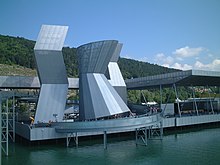
The newspapers Bieler Tagblatt and Journal du Jura as well as the only totally bilingual German/French newspaper Biel-Bienne with its large free distribution within the greater area, are published in Biel.
The domicile of the Theater Biel Solothurn is situated in the old town.
The town is also known for its annual International Chess Festival.
The town of Biel/Bienne received the Wakker Prize in 2004.
Each June since 1959, Biel has hosted a 100 km Ultramarathon race, which is among the biggest races of its kind worldwide and forms a part of the European Ultramarathon Cup.
Transport

Biel/Bienne is very well connected to its region and to Switzerland as well.
The public transport in and around Biel/Bienne is operated by
The fare network includes any mode of public transport, such as any kind of train (including the urban S-Bahn), PostAuto buses, trams, buses (either trolleybuses or motorized buses) and others. Fares are based on the number of zones crossed during a specified time and are independent of the mode of transport or the number of connections. Most part of Biel/Bienne and including Nidau belong to fare zone 300, including Vingelz/Vigneules in the southwest at the lake, but excluding Hohfluh on the Magglingen funicular and the Bözigerfeld/Champs-de-Boujean in the northeast, which belong to zone 301.
The circle fare zone 301 around Biel/Bienne also includes
in the south of the municipality. ). It is a central railway junction on the fast east–(south-)west line and on the Basel–Bern line. The station is Switzerland's thirteenth most busy railway station (about 52,0000 passengers per working day in 2016).One
The port at the north-eastern end of
Several bridges over the Nidau-Büren Canal connect the town to its south/eastern suburbs.
Biel/Bienne is well connected to other Swiss cities by several
The town is very well connected to all Swiss international airports:
Sport
- EHC Biel, the professional ice hockey team
- FC Biel-Bienne, the football club.
Notable people
Honoured citizen
- Nicolas Hayek (1928–2010) a Lebanese-American Swiss businessman, co-founder, CEO and Chairman of the Board of The Swatch Group. Promoted to honourable citizenship in 2004, official ceremony held on 19 February 2005[39]




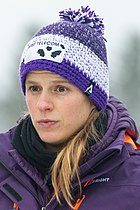
Born in Biel/Bienne
- Middle Ages
- Thomas Wyttenbach (c. 1472–1526), one of the reformers of the city of Biel during the Protestant Reformation.
- Emanuel Witz (1717–1797), a Swiss painter
- Eduard Blösch (1807–1866), a Swiss politician, President of the Swiss National Council 1855–1856
- Léo-Paul Robert (1851–1923), Swiss painter
- 19th C
- Karl Walser (1877–1943), a Swiss painter, stage designer, illustrator, muralist and artist
- Robert Walser(1878–1956), a German-speaking Swiss writer
- Ernst Dubach (1881–1982), a Swiss racing cyclist, the Swiss National Road Race champion in 1902
- Louis Rivier (1885–1963), a Swiss painter, writer, and stained glass artist
- Hans Zulliger (1893–1965), a Swiss teacher, child psychoanalyst and author
- Anna Renfer (1896-1984), a Swiss composer
- 20th C
- Jean-Louis Jeanmaire (1910–1992), a brigadier in the Swiss army who passed highly classified Swiss military secrets to the Soviet Union from 1962 until he retired in 1975
- Roland Kuhn (1912–2005), a Swiss psychiatrist who discovered that the drug imipramine had antidepressant properties
- Walter Kistler (1918–2015), a physicist, inventor and philanthropist
- Maurice Edmond Müller (1918–2009), orthopedic surgeon, developed internal fixation techniques to fix bone fractures
- Géo Voumard (1920–2008), a Swiss jazz pianist and composer, co-founded the Montreux Jazz Festival
- Felix Villars (1921–2002), American professor of physics at MIT, worked in quantum field theory, emigrated in 1949
- Henriette Grindat (1923–1986), a Swiss photographer, contributed to artistic photography, taking a Surrealist approach
- René Felber (1933–2020), a Swiss politician, member of the Swiss Federal Council 1987–1993
- Raymond Bruckert (born 1935) – writer of novels and educational books
- Ernst Thomke (born 1939), businessman, a corporate saviour by interventions
- Franz Hohler (born 1943), author of one-man and satirical programs for TV and radio, and cabaret artist.[40]
- Christian Philipp Müller (born 1957), a Swiss artist
- Thomas Jordan (born 1963), chairman of the Swiss National Bank
- Ian Christe (born 1970), an author, disc jockey and the publisher of Bazillion Points Books
- Denis Simonet (born 1985), a Swiss Pirate Party politician
- Eurovision 2024
- Sport
- Nicolas Bührer (born 1944) a Swiss entrepreneur and former racing driver
- Enzo Calderari (born 1952) a Swiss entrepreneur and former racing driver
- Robert Lüthi (born 1958) a retired Swiss footballer, played 291 games for Neuchâtel Xamax
- Étienne Dagon (born 1960) a former breaststroke swimmer, bronze medallist at the 1984 Summer Olympics
- Sven Christ (born 1973) a Swiss football manager and former football player with 427 games
- Andréa Zimmermann (born 1976) a Swiss ski mountaineer and mountain runner
- Yannick Pelletier (born 1976) a Swiss chess player who lives in Paris
- Marcel Fischer (born 1978) a Swiss fencer, gold medallist in the Men's Épée Individual at the 2004 Summer Olympics
- Ares (Marco Jaggi) (born 1980) a Swiss professional wrestler and wrestling trainer
- Raphael Nuzzolo(born 1983) a Swiss professional footballer, played over 475 games
- Martina Kocher (born 1985) a Swiss luger, competed in the 2006 and 2010 Winter Olympics
- Pietro Di Nardo (born 1990) a Swiss professional footballer, played over 250 games
- Gregory Hofmann(born 1992) a professional ice hockey player
- Nicola Todeschini (born 1997) a Swiss figure skater
Lived in Biel/Bienne

- Paul Käser (1904–??) a Swiss rower active in the 1920s and 1930s
- Henri Dubuis (1906–2003) a Swiss architect, designed and built the Volkshaus in Biel/Bienne in 1932
- Daniel Gisiger (born 1954) a retired Swiss road and track cyclist
- Jonas Kocher (born 1977) a musician, accordionist and composer
- Arno Camenisch (born 1978) a Swiss writer in German and Romansh
- Henri Laaksonen (born 1992) a Swiss-Finnish tennis player
- Oliver Hegi (born 1993) a Swiss male artistic gymnast and member of the national team
- Jil Teichmann (born 1997) a Spanish-born Swiss tennis player
Gallery
-
Lake Bienne
-
town's park
-
the river Suze
-
Place du Ring
-
old town
-
old town
-
old town
See also
References
- ^ a b "Arealstatistik Standard - Gemeinden nach 4 Hauptbereichen". Federal Statistical Office. Retrieved 13 January 2019.
- ^ Error: Unable to display the reference properly. See the documentation for details.
- Latin: Belna
- ^ Swiss Federal Statistical Office (FSO) (ed.). "Räumliche Gliederungen". www.bfs.admin.ch (in German). Retrieved 13 March 2024.
- ^ "Living in Switzerland's largest bilingual city". City of Biel/Bienne. Retrieved 13 March 2024.
- ^ Swiss Institute of Bioinformatics. "SIB Days 2016". sibdays.sib.swiss. Retrieved 13 March 2024.
- ^ a b "Amtliches Gemeindeverzeichnis der Schweiz" (Official site) (in German, French, and Italian). Neuchâtel, Switzerland: Federal Statistical Office, Swiss Confederation. Retrieved 21 August 2023.
- ^ Vingelz in German, French and Italian in the online Historical Dictionary of Switzerland.
- ^ Mett in German, French and Italian in the online Historical Dictionary of Switzerland.
- ^ a b c d e f g h i Biel/Bienne in German, French and Italian in the online Historical Dictionary of Switzerland.
- ^ Amtliches Gemeindeverzeichnis der Schweiz, Ausgabe 2006 Archived 18 July 2011 at the Wayback Machine, S. 271
- ^ Arealstatistik Standard - Gemeindedaten nach 4 Hauptbereichen
- ^ a b Swiss Federal Statistical Office-Land Use Statistics 2009 data (in German) accessed 25 March 2010
- ^ "Climate Norm Value Tables". Climate diagrams and normals from Swiss measuring stations. Federal Office of Meteorology and Climatology (MeteoSwiss). Archived from the original on 14 May 2013. Retrieved 30 January 2013. The weather station elevation is 433 meters above sea level.
- ^ Flags of the World.com accessed 12-August-2012
- ^ "Rechtssammlung: 14 Politische Rechte" (official site) (in French and German). Biel/Bienne, Switzerland: Biel/Bienne. 9 June 2013. Retrieved 9 January 2021.
- ^ a b c "Bieler Wahlen 2020" (official site) (in French and German). Biel/Bienne, Switzerland: Biel/Bienne. 27 September 2020. Retrieved 9 January 2021.
- ^ "Der Gemeinderat: die Stadtregierung" (official site) (in French and German). Biel/Bienne, Switzerland: Biel/Bienne. 1 January 2021. Retrieved 9 January 2021.
- ^ "Conseil de ville" (official site) (in French and German). Biel/Bienne, Switzerland: Stadt Biel/ Ville de Bienne. Secrétariat du Conseil général. Retrieved 17 November 2016.
- ^ a b Swiss Federal Statistical Office, FSO, ed. (28 November 2019). "NR - Ergebnisse Parteien (Gemeinden) (INT1)" (CSV) (official statistics) (in German, French, and Italian). Neuchâtel, Switzerland: Swiss Federal Statistical Office, FSO. Retrieved 18 May 2020 – via opendata.swiss.
- ^ a b Swiss Federal Statistical Office, FSO, ed. (28 November 2019). "NR - Wahlbeteiligung (Gemeinden) (INT1)" (CSV) (official statistics) (in German, French, and Italian). Neuchâtel, Switzerland: Swiss Federal Statistical Office, FSO. Retrieved 18 May 2020 – via opendata.swiss.
- ^ Swiss Federal Statistical Office 2011 Election Archived 14 November 2013 at the Wayback Machine (in German) accessed 8 May 2012
- ^ "Ständige und nichtständige Wohnbevölkerung nach institutionellen Gliederungen, Geburtsort und Staatsangehörigkeit". bfs.admin.ch (in German). Swiss Federal Statistical Office - STAT-TAB. 31 December 2020. Retrieved 21 September 2021.
- ^ a b c d e Swiss Federal Statistical Office Archived 5 January 2016 at the Wayback Machine accessed 12-August-2012
- ^ a b c d e STAT-TAB Datenwürfel für Thema 40.3 – 2000 Archived 9 August 2013 at the Wayback Machine (in German) accessed 2 February 2011
- ^ Swiss Federal Statistical Office STAT-TAB – Datenwürfel für Thema 09.2 – Gebäude und Wohnungen Archived 7 September 2014 at the Wayback Machine (in German) accessed 28 January 2011
- ^ Swiss Federal Statistical Office-Rental prices Archived 23 April 2010 at the Wayback Machine 2003 data (in German) accessed 26 May 2010
- ^ Stat Fact Sheet biel-bienne.ch
- ^ "Hotellerie: Angebot und Nachfrage der geöffneten Betriebe in 100 Gemeinden nach Jahr, Monat und Gemeinde". Swiss Federal Statistical Office. 13 November 2017. Retrieved 13 November 2017.
- ^ "Kantonsliste A-Objekte". KGS Inventar (in German). Federal Office of Civil Protection. 2009. Archived from the original on 18 September 2020. Retrieved 13 November 2017.
- ^ Centre, UNESCO World Heritage. "Prehistoric Pile Dwellings around the Alps". whc.unesco.org.
- ^ palafittes.org UNESCO nomination files-Volume II: Id-files of the component parts of the serial, Sites Switzerland (2) Archived 25 April 2012 at the Wayback Machine accessed 12-August-2012
- ^ "1935 – 1975: 40 Jahre Montage Suisse" [1935 - 1975: 40 years of Swiss assembly] (in German). General Motors Suisse SA. 16 December 2009. Archived from the original on 12 April 2014.
- ^ Swiss Federal Statistical Office STAT-TAB Betriebszählung: Arbeitsstätten nach Gemeinde und NOGA 2008 (Abschnitte), Sektoren 1–3 Archived 25 December 2014 at the Wayback Machine (in German) accessed 28 January 2011
- ^ a b Swiss Federal Statistical Office – Statweb (in German) accessed 24 June 2010
- ^ EDK/CDIP/IDES (2010). Kantonale Schulstrukturen in der Schweiz und im Fürstentum Liechtenstein / Structures Scolaires Cantonales en Suisse et Dans la Principauté du Liechtenstein (PDF) (Report). Retrieved 24 June 2010.
- ^ Schuljahr 2010/11 pdf document Archived 2 June 2012 at the Wayback Machine(in German) accessed 4 January 2012
- ^ Swiss Federal Statistical Office, list of libraries Archived 6 July 2015 at the Wayback Machine (in German) accessed 14 May 2010
- ^ "Ville de Bienne — Bienne Accueil". www.biel-bienne.ch.
- ^ IMDb Database retrieved 29 November 2018
External links
- Official website of Biel/Bienne
- Tourism Biel Seeland
- Biel/Bienne in German, French and Italian in the online Historical Dictionary of Switzerland.
- Coolidge, William Augustus Brevoort (1911). . Encyclopædia Britannica. Vol. 3 (11th ed.). pp. 920–921.
- Biel International Chess Festival
- Federation of the Swiss Watch Industry FH
- Chamber of economy Biel-Seeland




















